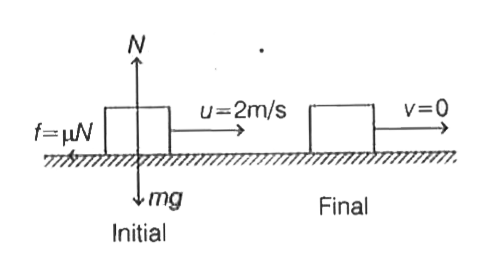A small body of mass 500 g moves on a rough horizontal surface before finally stops. The initial velocity of the body is 2 m/s and coefficient of frictin is 0.3 Then, find absolute vlaue of the average pwoeer develped by the frictional force during the time of motion. (Take g=10m/s2)Solution in Telugu
1W
1.5W
2W
2.5W
The correct Answer is:B

As, retardation is constant, so average velocity
vav=u+v2=2+02=1m/s
Now, friction force, f=μN=μmg
Given, coefficient of friction, μ=0.3
Mass of body, m=500g=0.5kg
⇒f=0.3×0.5×10
f=1.5N
Average power by friction,
Pav=fvav
Pav=1.5×1=1.5W
Topper's Solved these Questions
Similar Questions
Assertion (A) When we bounce a ball on the ground, it comes to rest after a few bounces, losing all its energy. This is an example of violation of conservation of energy.
Reason (R) Energy can change from one form to another but the total energy is always conserved.
Which of the following is true?
View SolutionMatch the following fundamental forces of nature with their relative strength.
List-IList-II(A)Strong nuclear force(i)10−2(B)Weak nuclear force(ii)1(C)Elextromagnetic force(iii)10−39(D)Gravitational force(iv)10−13
The correct match is
View SolutionA body of mass m is kept on a rough horizontal surface of friction coefficient m . A force P is applied horizontally , but the body is not moving .Find the net force F excerted by the surface on the body .
View SolutionA body starts rolling over a horizontal surface with an initial velocity of 0.5m/s. Due to friction , its velocity decreases at the rate of 0.05m/s2. How much time will it take for the body to stop?
View SolutionA bullet of mass 10 g moving horizontally with a speed of 400 m//s a block of mass 390 g and remains in it. The block slides 10 m on rough surface before coming to rest. The friction coefficient is
View SolutionOn a rough horizontal surface, a body of mass 2 kg is given a velocity of 10 m / s . If the coefficient of friction is 0.2 and g=10m/s2, the body will stop after covering a distance of
View SolutionA small body of mass m moving with velocity v0 on rough horizontal surface, finally stops due to friction. Find, the mean power developed by the friction force during the motion of the body, if the frictional coefficient μ=0.27,m=1 kg and v0=1.5ms−1.
View SolutionThe block of mass 4kg is placed on a rough horizontal surface having the coefficient of kinetic and static friction as 0.4 and 0.5 respectively. If a force of 4N is applied to the body, then the frictional force acting on the body will be [g= m/s^2 ]
View SolutionA body is projected with a initial velocity of (8hati+6hatj) m s^(-1) . The horizontal range is (g = 10 m s^(-2))
View SolutionA force of 500 dyn is applied against the motion of a body of mass 50 g moving at 1 m cdot s^(-1) . When and where will the body stop?
View Solution500 g द्रव्यमान का एक पिंड एक खुरदरे क्षैतिज मेज पर फिसलता है यदि पिण्ड तथा मेज के मध्य गुणांक 0.2 है तथा पिण्ड की प्रारम्भिक चाल60cm/s है । तब किया गया कार्य होगा
View Solution500 g द्रव्यमान का एक पिंड एक खुरदरे क्षैतिज मेज पर फिसलता है यदि पिण्ड तथा मेज के मध्य गुणांक 0.2 है तथा पिण्ड की प्रारम्भिक चाल60cm/s है । तब
पिण्ड को विरामावस्था में लाने के लिए घर्षण बल द्वारा किया गया कार्य
View Solution500 g द्रव्यमान का एक पिंड एक खुरदरे क्षैतिज मेज पर फिसलता है यदि पिण्ड तथा मेज के मध्य गुणांक 0.2 है तथा पिण्ड की प्रारम्भिक चाल60cm/s है । तब
वह समय इस पर यह रुकता है यदि t = 0 पर पिण्ड का वेग 60 cm/s है
View SolutionA body of mass 10 kg moves on rough horizontal surface with initial velocity 10m/s and travels 500m before coming to rest. The coefficient of friction is
View SolutionA constant force F is pushing a 5 kg mass on a horizontal surface at a constant velocity of 2 m/s. The coefficient of friction between the surface and the mass is 0.3 (Take g = 10 m/s^2 ). If F acts along the direction of motion, the rate at which F is doing work (in watt)
View Solution
